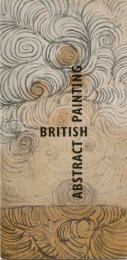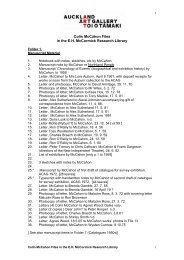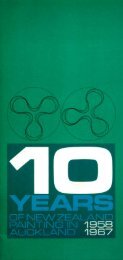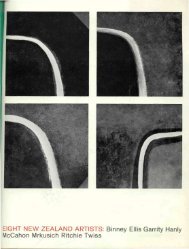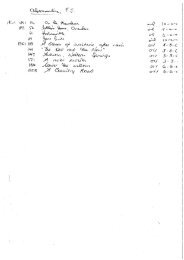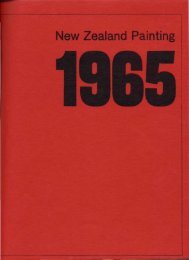PaintingsOther varieties of hanging mechanisms are available,such as D-rings or brass mirror-hangers. Nylon cord canbe used for light paintings and if picture-wire must beused, then multi-strand is the strongest. Picture wire cancause damage by poking into the back of a canvas paintingcausing distortions and cracking.Backing—backing boards should be used for paintingson canvas, and also for paintings on cardboard andwooden supports that are fragile or not sealed. Backingboards protect against blows to the reverse, deadinsects, dust and other grime that often ends up betweenthe canvas and stretcher beam. They provide a bufferagainst the environment, slowing the effect of temperaturefluctuations, high humidity, pollution and light.The type of backing that should be used depends onthe picture and what is available. Archival and normalcorrugated card can be used, as well as fluted polypropylene,foam core board, hardboard (heavy but strong) andeven acrylic sheeting (very useful if you wish the reverseto remain visible).Backing boards should be attached to the reverse ofthe frame (this can be facilitated by frame build-ups) byscrews, Velcro and/or tape. Taping provides a better dustand environmental shield, and various types can be usedsuch as double-sided, gummed cloth, aluminium tapeand gummed paper. If it is not possible to attach thebacking board to the frame and it must be attached tothe stretcher, do not attach tape to the canvas, as thiscould cause damage if removed when the canvasbecomes old and brittle.A backing board is an excellent place for labels; inno circumstances should labels or inscriptions be putdirectly on the reverse of the canvas.The Frame as Part of the <strong>Art</strong> Object—an originalframe can be an important part of the work of art. Theartist may have chosen it to complement or bring outsomething in the painting, and by removing it you couldalter the artist’s intent; or the frame may epitomise theage of the work, making it part of its history. Originalframes should therefore be reused if at all possible.Shadow Frames—a shadow frame is one that allowsthe edges of the painting to remain visible. This meansthat the painting will have to be screwed or glued to theframe from the back and cannot be held in by pressurealone. This is problematic because it involves permanentlychanging and possibly damaging the back of thepainting. Thin supports such as hardboard are difficultto attach to this type of frame without glueing, makingremoval extremely difficult. An alternative is to glueVelcro to the painting reverse and frame to hold the twotogether. Never glue over original inscriptions. Paintingson thick paper are best framed behind glass like works ofart on paper (see also page 14).StoragePaintings are safer on the walls than in poor storagefacilities where they are more likely to be knocked, torn,and become dirty and mouldy. Basic requirements of astorage area are a good environment with stable temperatureand humidity levels, no natural light and lowartificial light levels, clean, with good air circulation.The storage area should always be kept separate fromother activities to reduce the possibility of accidentaldamage. Other main points are listed below.Keep Paintings off the Ground—paintings are bestkept off the ground, primarily to avoid damage fromflooding, but also to protect the edges. Paintings shouldeither be kept in storage slots, drawers or screens forpermanent storage, or on padded blocks for temporarystorage. Padded blocks protect the base of the frame orpainting and stop slipping occurring. They can be madeof foam only, or foam on wood covered in cloth.Stacking Paintings—paintings should be stackedwith extreme care as damage to the artwork or frame isoften caused by this method of storage.Paintings should not be in direct contact with eachother and should be protected by a solid barrier such ascorrugated cardboard.Do not lean anything against the front or back of acanvas painting as this can result in distortions, crack-36
Paintingsing and tearing. Special precautions should be takenwith unframed paintings with delicate soft surfaces, asthese may be damaged by the cardboard itself and mayneed a travelling frame to keep everything away fromthe surface. Nothing should be leant directly against thefront of a painting.Paintings should be stacked vertically and placedface to face and back to back with corrugated cardboardsheets in between. This eliminates the danger of protrudingdecorations and hanging apparatus on framesdamaging the faces of adjacentpictures.Stack works of a similarsize together. Put the largestwork at the back, tapering tothe smallest at the front.Adjacent pictures must belarge enough to cross eachother completely. Do not stackpaintings that have fragilepaint layers. They should belaid flat and conservationadvice sought.Paintings should beStored in Frames—framesprotect pictures from abrasion.If not framed or in atravelling frame, a paintingshould be wrapped in Tyvek (asynthetic paper) or clean softtissue (preferably acid-free).Keep tape away from the front of the painting.Wrapping paintings in clean tissue or Tyvek is advisablefor those pictures with delicate surfaces, such as colourfieldpaintings or ones with bare canvas exposed. Thesetypes of pictures rely on surface effects and any damagecan be difficult or impossible to treat, ruining theintended effect of the artist. Plastic can also be wrappedaround these works if they are already wrapped intissue.The Frame as Part ofthe <strong>Art</strong> ObjectAn original frame can be an important partof the work of art. The artist may havechosen it to complement or bring out somethingin the painting, and by removing ityou could alter the artist’s original intent;or the frame may epitomise the age of thework, making it part of its history. Originalframes should therefore be reused if at allpossible.Plastic, including bubblewrap, should never come indirect contact with the paint surface, as the two layerscan adhere together or leave permanent marks on thepaint surface. The painting should be wrapped in anacid-free tissue or Tyvek first and the bubblewrap shouldbe wrapped with bubbles to the outside.Slot Storage—frequently paintings are packed intoslot storage units without any protection from the storagestructure or the other paintings. The results areabrasion, scratches, scuffing, breaks and tears. Theseare all things that could haveeasily be avoided with a minimumof expense. Paintingsshould not be stacked togetherwithout a protective layerbetween them.If you have a large numberof paintings to store, thenit is advisable to use a rigidstructure for this purpose.Moving screens are useful forlarge collections, but they areexpensive and therefore forsmaller collections slot storageis probably more practical.Slots prevent too muchpressure building up fromlarge numbers of paintingsleaning against each other.Slots are best made of sealedwood, having bases lined withcompact foam (such as expanded polyethylene) to protectframes and picture edges. Sheets of a rigid materialsuch as corrugated card should be used to separatethe paintings.Roll Storage—unstretched canvas paintings can bestored on screens if they have eyelets or Velcro, but otherwisethey will have to be stored flat or rolled. Paintingsshould not be rolled if they have a thick or brittle paintlayer, collage elements, or delicate support.37



